Malta is home to a diverse range of bird species, with over 350 recorded species of birds. This small island has a wide variety of habitats, making it an ideal spot for many different species of birds.
From the rocky cliffs of the Maltese Islands to the sandy beaches and lagoons, natural habitats are abundant for birds to thrive.
Malta is a major stopover for migrating species and provides a safe environment for a wide range of resident and migratory birds to nest and feed.
Malta offers something for any bird enthusiast, whether it’s a majestic eagle soaring through the sky or a tiny wren hopping in the bushes.
There is something truly magical about witnessing these birds’ beauty up close, and there is no better place to do it than in Malta.
19 Birds Found in Malta
If you are a bird lover, you might want to visit Malta, a small island nation in the Mediterranean Sea. Malta is home to a diverse range of bird species, with over 350 recorded species of birds.
This small island has a wide variety of habitats, making it an ideal spot for many different species of birds. From the rocky cliffs of the Maltese Islands to the sandy beaches and lagoons, natural habitats are abundant for birds to thrive.
Here are 19 birds found in Malta that you might encounter during your visit.
1. Barn Owl
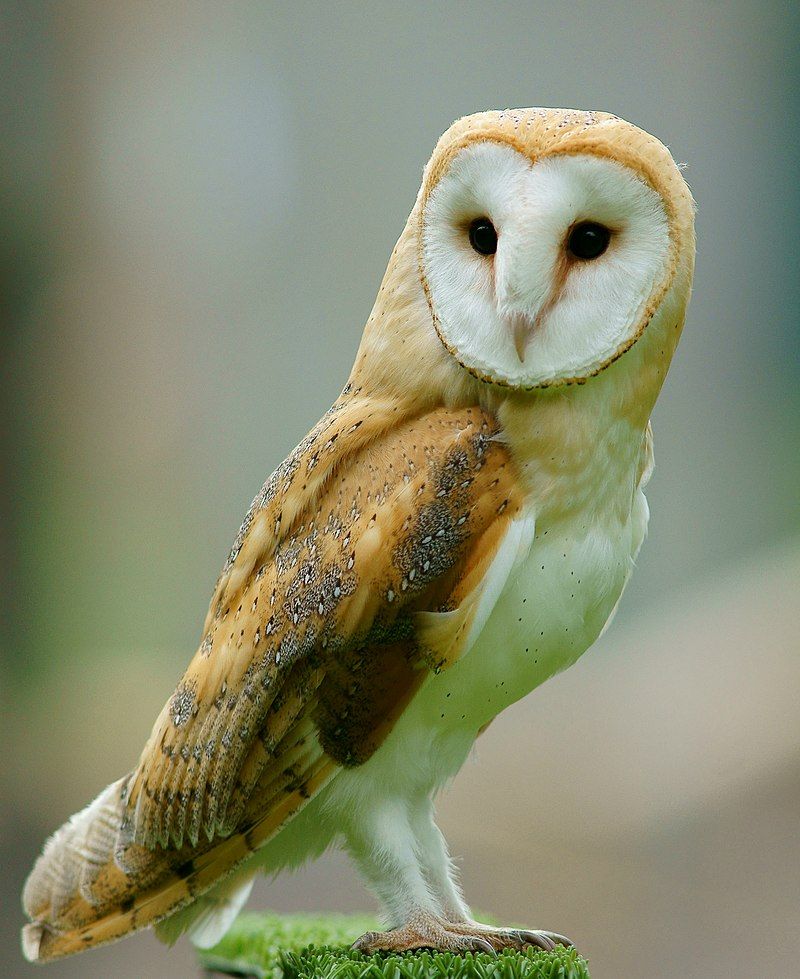
The barn owl is a species of owl found almost everywhere on Earth except for a few areas. It is widely distributed worldwide, being present in regions ranging from the Arctic Circle to the tropics.
This species is even more widespread than many other species of birds, making it one of the most abundant avian species on the planet.
The only areas where the barn owl is not found include the polar and desert regions, most of Indonesia, Asia north of the Himalayas, and some Pacific Islands. The barn owl is a fascinating species with various adaptations that allow it to thrive in different habitats.
It has a unique, heart-shaped face adapted for silent flight in pursuit of small mammals, and its nocturnal behavior helps it avoid competition with diurnal species.
Its white-and-gray patterned feathers also provide camouflage against its typical roosting and nesting sites. These features, combined with its wide distribution, have allowed the barn owl to become one of the world’s most abundant species of owl.
| Kingdom | Animalia |
| Phylum | Chordata |
| Class | Aves |
| Order | Strigiformes |
| Family | Tytonidae |
| Genus | Tyto |
| Species | T. alba |
2. Glareolidae
Glareolidae is a family of birds that belongs to the wader suborder Charadrii. It is comprised of two main groups: the pratincoles and the coursers. The family includes 17 species spread across four different genera.
One species, the Egyptian plover, is traditionally placed within this family but is now known to be only distantly related. Pratincoles are wading birds, typically with long wings and short legs.
They typically inhabit open grasslands and wetlands and feed on insects, small fish, and other small animals. On the other hand, Coursers are characterized by their long legs and short wings.
They are found in dry regions and use their long legs to run after their prey. The Egyptian plover is unique among the species within Glareolidae. It is a small bird that typically inhabits the banks of rivers and lakes.
It feeds on small insects and other invertebrates living in the mud and sand. Unlike the different species within the family, it does not wade into the water to feed. Glareolidae is an essential family of birds that plays a vital role in the global ecosystem.
Its species are found in many regions worldwide and provide critical ecological services such as pest control and seed dispersal. They are also an important food source for many other animals.
| Kingdom | Animalia |
| Phylum | Chordata |
| Class | Aves |
| Order | Charadriiformes |
| Family | Glareolidae |
3. Cisticolidae
The family Cisticolidae is an essential group of birds. These birds are classified as singers and are small passerine birds, meaning they are passerines with a melodic song.
These birds are primarily found in warmer regions of the Old World, which includes Europe, Asia, and Africa. They are sometimes found in the temperate areas of the Old World as well. Before, the family Cisticolidae was included in the Old World warbler Sylviidae.
This family typically includes tiny birds with long, thin bills and short wings. They are generally insectivorous and can be found in a variety of habitats. Sylviidae includes many popular species, such as the European Robin and the Eurasian Blackcap.
The family Cisticolidae is an essential group of birds previously included in the Old World Warbler Sylviidae family. They are found mainly in warmer regions of the Old World and can be identified by their small size, melodic song, and insectivorous diet.
| Kingdom | Animalia |
| Phylum | Chordata |
| Class | Aves |
| Order | Passeriformes |
| Family | Cisticolidae |
4. Penduline tits
The Remizidae family is a group of small passerine birds commonly known as penduline tits. They are closely related to the true tits, which are also small passerine birds.
There are several species of penduline tits, but the verdin is the only one that does not make a bag nest. The other species build their nests by weaving elaborate bags out of plant material and hanging them from trees, usually over bodies of water.
The nests are often densely woven and suspended horizontally and can be found in various shapes and sizes. The nests protect the eggs and young and have been known to last for many years.
Penduline tits are found in many parts of the world, from Europe to Africa and Asia, and are a valuable asset to the ecosystem.
| Kingdom | Animalia |
| Phylum | Chordata |
| Class | Aves |
| Order | Passeriformes |
| Family | Remizidae |
5. Rollers
Coraciidae is a family of birds from the Old World, which is more commonly known as rollers. These birds are named as such due to the impressive aerial acrobatics they perform during courtship or territorial flights.
This behavior is a highly evolved mating ritual that attracts potential mates or wards off intruders in their territory. During these impressive displays, the bird will often dive, roll, and loop through the air while making a loud, shrill call.
This behavior is often beautiful and can be seen in many parts of the world.
| Kingdom | Animalia |
| Phylum | Chordata |
| Class | Aves |
| Order | Coraciiformes |
| Family | Coraciidae |
6. Acrocephalidae
The Acrocephalidae family of birds is part of the Sylvioidea superfamily. These birds are commonly called “warblers” and are usually quite large.
Most Acrocephalidae have an olivaceous brown coloration on their upper parts and have yellow to beige colorations on their undersides. These birds are typically found in open woods, reedbeds, or tall grass.
They are usually very plain in their plumage and thus can be hard to spot in their natural habitats. The Acrocephalidae are pretty adaptable and can be found in various environments. They are known to inhabit wetlands, grasslands, and even urban areas.
They feed on various insects, worms, and other small invertebrates. They are usually quite timid but can be pretty vocal during mating season.
The Acrocephalidae family is quite diverse and includes species such as the marsh warbler, the Cetti’s warbler, the aquatic warbler, and the barred warbler. These species have adapted to their respective environments and have different behaviors and habitats.
For example, the marsh warbler is usually found in wetlands, while the barred warbler is in woodlands. The Acrocephalidae family is an integral part of the ecosystem, as they play an important role in insect control.
They are also an essential part of the avian community, as they provide food for other birds, and their songs can be heard in many areas. It is necessary to protect these birds, as their numbers are declining in many areas due to habitat loss and other threats.
| Kingdom | Animalia |
| Phylum | Chordata |
| Class | Aves |
| Order | Passeriformes |
| Family | Acrocephalidae |
7. Locustellidae
Locustellidae is a recently identified family of small insectivorous songbirds. It was previously placed in the Old World warbler family, often called the “wastebin” family because of its varied and diverse composition.
This family contains grass warblers, grassbirds, and the Bradypterus “bush warblers.” These birds are mainly found in Eurasia, Africa, and the Australian region. Grass warblers are small, drab-colored birds that inhabit grasslands and marshes.
They feed mainly on insects, which they catch by flying low over the vegetation. Grassbirds are slightly larger than the grass singers but have similar markings and behavior. They inhabit open grasslands and savannas and feed by probing the soil for insects.
The Bradypterus “bush warblers” are a group of small, brownish-colored birds that inhabit forests and woodlands. They are active during the day and feed mainly on insects. They have a distinctive song, usually a mixture of short, high-pitched notes.
The Locustellidae family represents an integral part of the global aviation community. These birds play an important role in maintaining the balance of the ecosystem by preying on insects, and their songs are an essential part of the soundscape of many parts of the world.
| Kingdom | Animalia |
| Phylum | Chordata |
| Class | Aves |
| Order | Passeriformes |
| Family | Locustellidae |
8. New World Sparrow
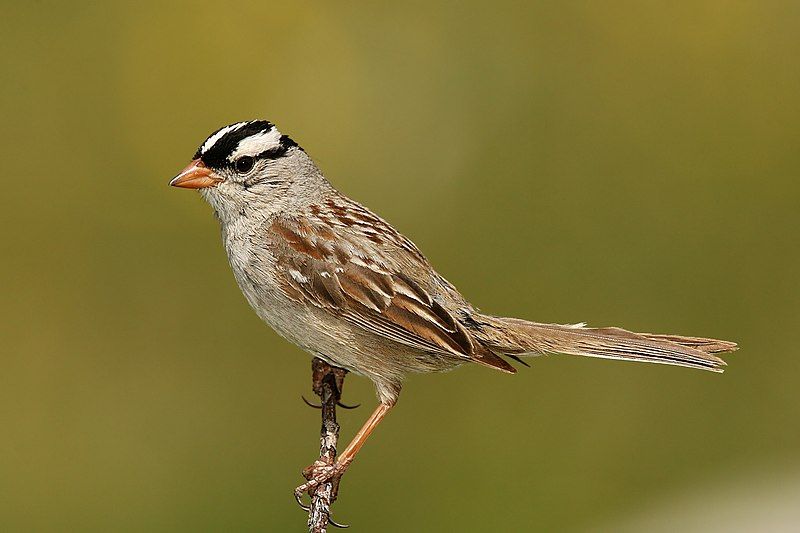
New World sparrows are a type of bird that belongs to the family Passerellidae and are native to the New World. They are small passerine birds with conical-shaped bills and primarily brown or gray feathers.
Many species of New World sparrows have unique markings on their heads, such as stripes, spots, or other patterns, that distinguish them from other birds of a similar size. New World sparrows feed mainly on seeds and are often seen foraging in groups on the ground.
They are known for being adaptable and can be found in various habitats, from grasslands to wetlands to urban areas, making them an essential part of the local ecosystem.
These birds are also very vocal and often produce a variety of chirps, songs, and other calls to communicate and attract mates. In recent years, some species of New World sparrows have become increasingly rare due to habitat destruction and other human activities.
Conservation efforts are underway to protect these birds and ensure their future survival.
| Kingdom | Animalia |
| Phylum | Chordata |
| Class | Aves |
| Order | Passeriformes |
| Family | Passerellidae |
9. Scopoli’s Shearwater
Scopoli’s shearwater is a species of seabird in the Petrel family, Procellariidae. It is native to the Mediterranean region, where it breeds on rocky islands and steep coastal areas.
During the non-breeding season, these birds migrate west to forage in the Atlantic Ocean. Scopoli’s shearwater has a brownish-grey coloration across its back, wings, and tail, while its underside is primarily white.
Its wingspan is usually around 70 cm, and its average weight is 340 g. The shearwater’s diet consists mainly of fish, squid, crustaceans, and other marine life. It forages by diving underwater to depths of up to 20 meters, using its wings to propel itself.
During the breeding season, these birds form monogamous pairs, and the male and female will share the task of incubating the eggs and raising the chicks.
They will also display a unique courtship display before mating, which involves the male fluttering around the female and calling out in a high-pitched voice. Overall, Scopoli’s shearwater is an exciting species of seabird that is highly adapted to life in the marine environment.
It is a vital part of the Mediterranean ecosystem, and its conservation is essential.
| Kingdom | Animalia |
| Phylum | Chordata |
| Class | Aves |
| Order | Procellariiformes |
| Family | Procellariidae |
| Genus | Calonectris |
| Species | C. diomedea |
10. White Stork
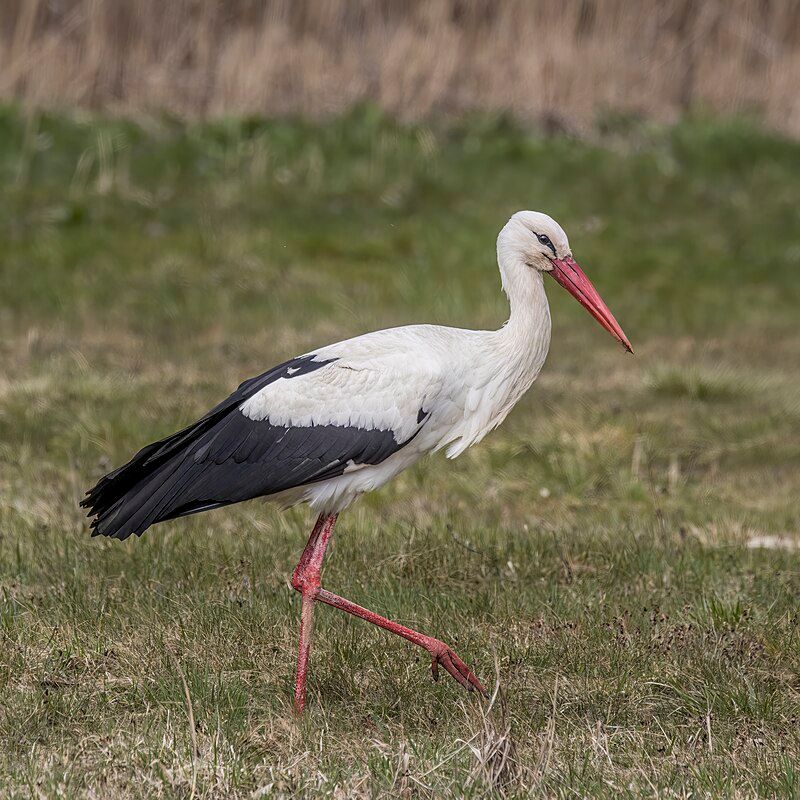
The White Stork is a large bird species in the Ciconiidae family known for its distinctive white plumage. The bird’s wings are covered in black feathers, with the rest of the body covered in white.
It is easily identifiable by its long, red legs and its long, pointy, red beak. On average, the White Stork is between 100 and 115 centimeters long, measuring from the beak tip to the end of its tail.
Its wingspan, measuring between 155 and 215 centimeters, is also impressive.
| Kingdom | Animalia |
| Phylum | Chordata |
| Class | Aves |
| Order | Ciconiiformes |
| Family | Ciconiidae |
| Genus | Ciconia |
| Species | C. ciconia |
11. Blue Rock Thrush
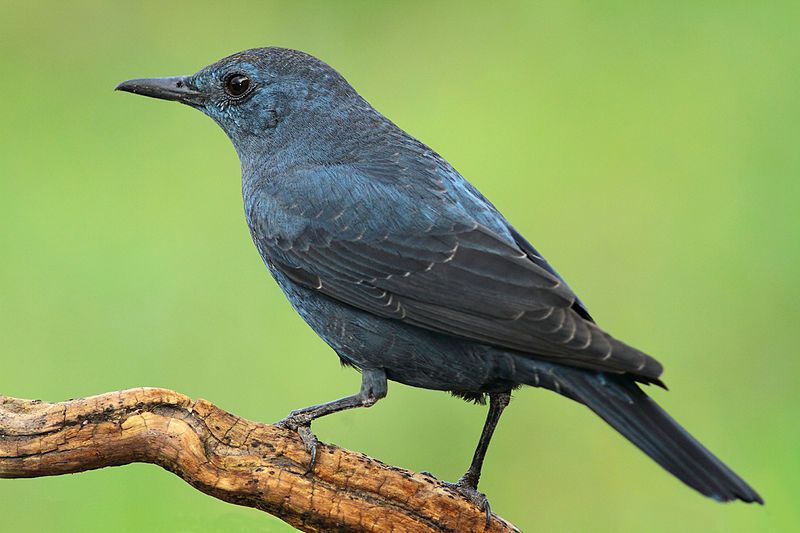
The blue rock thrush is a species of chat, an Old World flycatcher. This species of bird was previously categorized in the Turdidae family.
It can be found in various parts of the world, from southern Europe and northwest Africa to Central Asia, northern China, and Malaysia. They have a thrush-like appearance and tend to inhabit warm, sunny areas.
The blue rock thrush typically builds its nest on rocky cliffs and is often seen perched on rocks, branches, or other elevated areas. It is an omnivorous species that feeds on fruits, insects, and other small invertebrates.
This species is also known for its remarkable singing skills and is often heard singing in the morning or evening. The blue rock thrush is a solitary species rarely found in large flocks.
During the breeding season, males display a range of behaviors to attract a mate, such as singing, flicking their wings, and chasing other birds away. This species is monogamous, and both parents take part in feeding and caring for their young.
The blue rock thrush is a fascinating species in many parts of the world. Its unique appearance, singing abilities, and solitary nature make it an interesting species to observe.
| Kingdom | Animalia |
| Phylum | Chordata |
| Class | Aves |
| Order | Passeriformes |
| Family | Muscicapidae |
| Genus | Monticola |
| Species | M. solitarius |
12. Western Marsh Harrier
The western marsh harrier is a bird of prey native to temperate and subtropical regions of West Eurasia and parts of Africa. It is a large harrier of the genus Circus and is also known as the Eurasian marsh harrier.
This species was formerly grouped with related species under the single species of C. aeruginosus, which was then referred to as the ‘marsh harrier.’
It is a medium-sized bird of prey, with males typically weighing between 500 and 1000 grams and females between 600 and 1100 grams. The species has a gray-brown body with white patches on its wings and tail. It primarily hunts small mammals, birds, and insects.
The western marsh harrier is present in numerous protected areas across its range and is listed as a species of most minor concern on the IUCN Red List.
| Kingdom | Animalia |
| Phylum | Chordata |
| Class | Aves |
| Order | Accipitriformes |
| Family | Accipitridae |
| Genus | Circus |
| Species | C. aeruginosus |
13. Spanish Sparrow
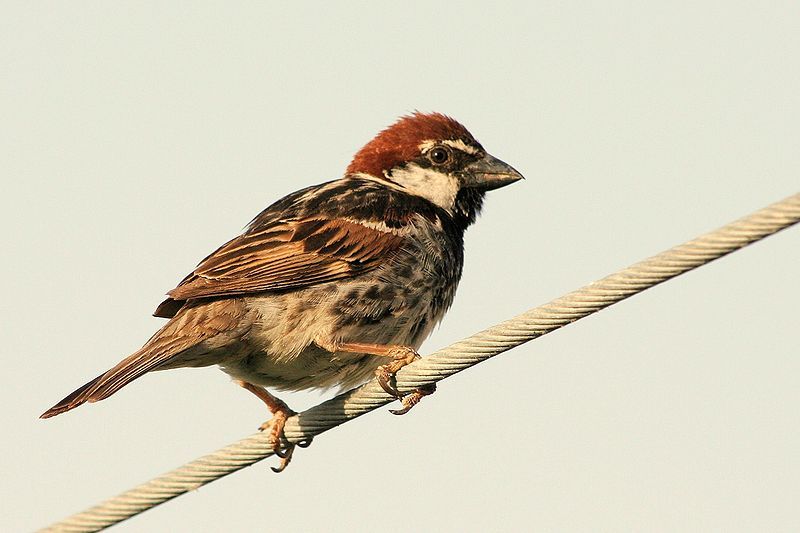
The Spanish sparrow, also known as the willow sparrow, is a small, perching bird belonging to the Passeridae family of sparrows. It is native to the Mediterranean region, as well as southwest and central Asia.
It is a small bird, typically measuring between 12 and 15 centimeters in length, with a wingspan of around 22-25 centimeters. Its plumage is mainly grey-brown, with a white belly and a distinctive black line running along its crown.
It also has a black line running along its cheeks and a white stripe on its wings. The Spanish sparrow is found in various habitats, including open woodlands, scrublands, and grasslands.
It prefers areas with low trees and shrubs, which provide shelter from predators. It feeds primarily on seeds and invertebrates, which it can find in the ground and vegetation.
It is also known to forage for food in grassy meadows and crop fields. The Spanish sparrow is a social bird, often found in small flocks. It is known to form strong pair bonds and is monogamous.
Breeding pairs typically build their nests in trees or shrubs, and the female lays up to five eggs. Both parents feed the chicks, and they fledge after about two weeks. The Spanish sparrow is a common species with a wide range and a large population.
It is not currently threatened and is listed as a species of most minor concern by the IUCN. However, its numbers have been declining due to habitat destruction, as well as the use of pesticides and insecticides in agricultural areas.
| Kingdom | Animalia |
| Phylum | Chordata |
| Class | Aves |
| Order | Passeriformes |
| Family | Passeridae |
| Genus | Passer |
| Species | P. hispaniolensis |
14. Spectacled Warbler
The spectacled warbler is a species in the typical warbler genus Curruca. It gets its name from the Latin word conspicillata, which means a place to look from. This is equivalent to the English word “spectacled,” which means wearing glasses or binoculars to look from a distance.
The spectacled warbler is a small bird, usually found in dry and desert-like habitats. It is a migratory species in the Mediterranean, North Africa, the Middle East, and Western Asia. The spectacled warbler lives in scrubland, arid grassland, and light woodland.
It feeds on insects and other invertebrates and occasionally on tiny seeds. The species is usually solitary but can also be found in pairs or small family groups. It is a shy bird and prefers to stay hidden in the dense vegetation.
Its loud song usually reveals its presence, composed of a mixture of chirps and trills. The spectacled warbler is an essential species for conservation, as human activities often threaten its habitats.
| Kingdom | Animalia |
| Phylum | Chordata |
| Class | Aves |
| Order | Passeriformes |
| Family | Sylviidae |
| Genus | Curruca |
| Species | C. conspicillata |
15. Black-Winged Stilt
The black-winged stilt is a long-legged wading bird from the avocet and stilt family, found in many parts of the world. Its scientific name is H. himantopus, often referring to a single, widespread species.
The black-winged stilt is a distinctive-looking bird with long, thin legs and a black patch on its wings. It can be found in wetlands, marshes, and shallow lakes and feeds on aquatic insects, crustaceans, and small fish.
It is a migratory bird, traveling between its breeding and wintering grounds. During the breeding season, the black-winged stilt builds its nest near water and can be found in large colonies. The female will lay two to four eggs, then incubated for around three weeks.
The chicks can fly after four to five weeks and remain with their parents for up to two months. The black-winged stilt is listed as a species of most minor concern by the International Union for Conservation of Nature.
| Kingdom | Animalia |
| Phylum | Chordata |
| Class | Aves |
| Order | Charadriiformes |
| Family | Recurvirostridae |
| Genus | Himantopus |
| Species | H. himantopus |
16. Yelkouan Shearwater
The yelkouan shearwater, also known as the Levantine shearwater or Mediterranean shearwater, is a species of seabird in the Procellariidae family. It is a medium-sized shearwater, typically measuring around 40 cm long, with a wingspan of around 80 cm.
The yelkouan shearwater can be found in the Mediterranean Sea, off the coasts of North Africa, and in the Atlantic Ocean. In the past, this shearwater species was treated as a subspecies of the Manx shearwater, a closely related species.
However, recent studies have shown that the yelkouan shearwater is a distinct species in its own right and is considered a valid species by the scientific community.
The yelkouan shearwater is a highly migratory species, with some individuals traveling as far as the United Kingdom and other parts of Europe during migration. This species feeds mainly on small fish and crustaceans, which it captures by diving underwater from the surface.
| Kingdom | Animalia |
| Phylum | Chordata |
| Class | Aves |
| Order | Procellariiformes |
| Family | Procellariidae |
| Genus | Puffinus |
| Species | P. yelkouan |
17. Moussier’s Redstart
Moussier’s redstart is a small species of bird belonging to the genus Phoenicurus. This bird is part of the family of Old World flycatchers, having previously been classified as a member of the thrush family.
This particular species is endemic to the region of the Atlas Mountains, which can be found in the northwestern part of Africa. It is a resident species, meaning it is found year-round rather than having a migratory pattern.
Furthermore, it is a breeding species that nests in the Atlas Mountains and produces offspring there. In summary, Moussier’s redstart is a small passerine bird found in the Atlas Mountains of northwest Africa, where it breeds and resides year-round.
| Kingdom | Animalia |
| Phylum | Chordata |
| Class | Aves |
| Order | Passeriformes |
| Family | Muscicapidae |
| Genus | Phoenicurus |
| Species | P. moussieri |
18. Greater Hoopoe-Lark
The greater hoopoe-lark is a passerine bird, a type of bird with a particular kind of beak and feet that are adapted for perching. It is a breeding resident of arid, desert, and semi-desert regions, meaning it has adapted to living in these harsh, dry environments.
It is found across a wide area, from the Cape Verde Islands to northern Africa, the Arabian peninsula, Syria, Afghanistan, Pakistan, and India. This bird is well-suited for living in these hot and dry climates, with its dry-adapted feathers and specialized diet.
It can survive in these extreme conditions, finding food and water as necessary. The greater hoopoe-lark is a fascinating species that has successfully survived in some of the harshest environments on the planet.
| Kingdom | Animalia |
| Phylum | Chordata |
| Class | Aves |
| Order | Passeriformes |
| Family | Alaudidae |
| Genus | Alaemon |
| Species | A. alaudipes |
19. Olive-Backed Pipit
The olive-backed pipit is a species of bird that belongs to the pipit genus. It is a small songbird found in various parts of Asia and Europe.
This species is widespread and breeds in South Korea, Japan, China, Russia, Mongolia, Thailand, and India.
It is also found in parts of northeastern European Russia. The olive-backed pipit is a long-distance migrant, which means it travels long distances during winter.
It migrates from its breeding grounds in Asia and Eastern Europe to the south to spend winter in southern Asia and Indonesia.
This species is known for its migratory behavior and ability to adapt to different habitats. The olive-backed pipit’s diet consists mainly of insects and seeds. It feeds primarily on the ground and in shallow waters.
During the breeding season, birds can be seen searching for food in open meadows and grasslands. In recent years, the olive-backed pipit’s population has declined due to habitat destruction and other human activities.
As a result, conservation efforts have been put in place to protect this species and its habitat.
| Kingdom | Animalia |
| Phylum | Chordata |
| Class | Aves |
| Order | Passeriformes |
| Family | Motacillidae |
| Genus | Anthus |
| Species | A. hodgsoni |
Conclusion
Malta is a great place to observe some of the world’s most beautiful and varied bird species. Various habitats and climatic conditions make it an ideal location for bird watching.
The many reserves and parks throughout the country provide excellent opportunities to observe resident and migratory birds. Bird watching in Malta is a great way to appreciate nature’s beauty and learn more about bird species found in the Mediterranean.